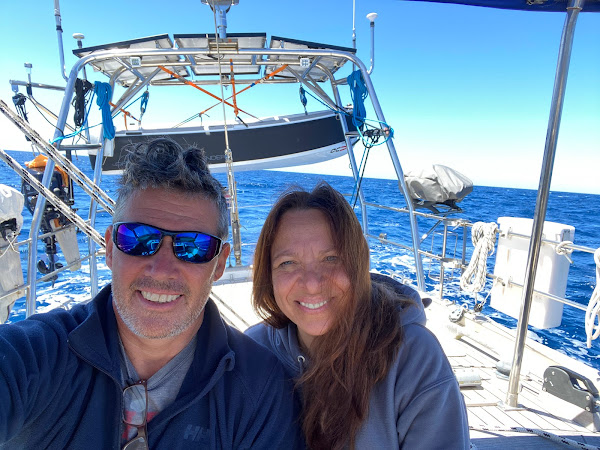We checked the weather and it looks like there are lots of weather changes on their way with a couple of large northerly and southerly systems due to pass in the next week. This could mean that we could be stuck here for a while and there are no all weather anchorages.
We had hoped to stop over in Trousers Bay but we ended up deciding that we had a good window to make it to Wineglass Bay in an overnight passage. Part of this journey requires planning to pass through Banks Strait between Flinders island and Mainland Tasmania. Like many straits Banks has strong currents flowing through it and can cause steep seas in strong winds so good timing and the right conditions are required.
Our projections showed that we could arrive at the strait at slack water with the 15-20kt wind predicted from the NE and as we passed through the current would build to spit us out the other side. This seemed too good an opportunity to miss soo we decided to go for it although somewhat disappointed that we did not see more of Flinders.
Our sail down the coast of Flinders and through the strait was absolutely wonderful. Like the day before the winds were 15kts on the beam and the seas were flat in the lee of the island. We were trucking along and very comfortable. We zipped through Bank at 8kts with less than 1m seas. Our price for a wonderful day and evening sail was for the winds to drop below 5 its, as predicted for the rest of the journey to Wineglass Bay through the night so we had to motor, something I am not keen on doing.
It was an uneventful night and the seas were flat so again it was comfortable. Still we have seen no boats or ships but have seen a stationary bright light to the east, presumed to be a drilling rig. The sun came up as we approached Wineglass and lit up the steep and colourful and intimidating cliffs of the Hazard Mountains and entrance to the Bay.
Finally a fellow sailor! as we entered deeper into Wineglass Bay we spotted a yacht tucked away in the north corner of the bay. As the winds were due to shift to the south in the next few hours we decided to anchor in the southern side of the Bay about 200 mts off the beach. Charts for this bay are not that great so it was hard to see how far we could get into the bay away from the ocean swell but with reports of another boat being washed up on the beach we traded comfort for caution.
After a brief time chilling, taking in the quite spectacular scenery we decided to head ashore for a walk along the crescent shaped white sand beach, strewn with shells, seaweed and the rotting carcass of a seal. Except for a couple of topless backpackers, according to Jude - she did not tell me until later, there was not a soul on the beach and we strolled to the north end and marvelled at the orange coloured rocks along the far shore.
Both Jude and I thought the scenery reminded us of our time in the Pacific North West and Alaska so we are so far very impressed with Tasmania!!
There is a path at the end of the beach that goes up the mountain to a lookout over the bay. Unfortunately we did not bring our shoes so we could not go up the 1000 steps so we walked back along the beach to the very basic backpacker campsite (wink wink).
We went back to the boat and picked up out hiking boots and walked back along the beach and up the 1000 step track to the lookout over the bay. When we returned to the dinghy from the walk it was time to go for a swim to cool off. The water looked so tempting. Clear and blue and calm. Surprisingly it was not too cold, probably about 19c
As we feared the swell coming in from the ocean made for a slightly unpleasant night sleep with the boat rolling when set broadside to the incoming swell.
One benefit of the restless night was seeing an amazing phosphoresce show in the water. I have nit seen the like since the Sea of Cortez in Mexico. The water was alive. Small illuminated specks with flashes streaking through the water, some quite large and predator chases prey up and down the food chain. I must have watched for an hour or so and made the uncomfortable night worth it!





























